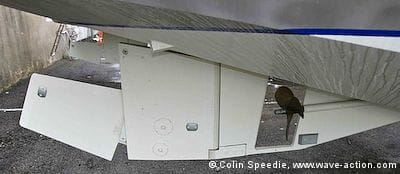For us the choice of boat was dictated by our need for a traveling base camp for our wildlife photography interests, as much as for recreation. As the places we wish to visit are generally remote from civilization, we need a craft that can go virtually anywhere, for extended periods, and be as self-sufficient as possible—something like an ocean going 4×4. We think that the OVNI 435 more than fits that bill.
All OVNIs offer the benefits of aluminum construction, including high strength to weight, resistance to penetration and abrasion together with integral fuel and water tanks. Combine this with the simplicity of modifying many elements of the construction and thus producing a semi-custom boat at the price of a good production boat, the package is attractive. In terms of what can be changed, the rule of thumb at the builder seems to be that if it has been done before, or will not materially slow down the production line, then it can be accommodated at modest or no extra cost. As ours will be OVNI 435 number 104, the design improvements and suggestions of the previous 103 buyers will ensure ours is as near to perfect as we can hope for.
Of the models on offer, the 435 has the most positive attributes of the range for us, including many “traditional” features such as a well-stayed cutter rig, a skeg hung rudder and protected propeller. The size is right for two of us to handle on our own, as well as being big enough to make a comfortable home with adequate tankage and carrying capacity. The sail plan is modest and well divided, and so should be easily manageable, important for us, as we both have backs that have seen better days!

The 435 draws 2’6” with the plate up, 8’4” with it down, and with a flat run along the centerline of the hull will sit upright when dried out on a level surface. Both plate and rudder are hydraulically controlled, and have an ingenious safety device in the manually operated pump, where copper plugs are designed to rupture in the event of either foil striking an object, allowing them to swing freely to avoid structural damage.
The benefit of true shoal draft like this opens up many cruising areas, and is ideal for the exploration we have in mind. Not only that, in many wild places, the ability to anchor further in can make a huge difference to comfort and safety in bad weather—with deep draft you are often sitting just too far out from shelter, sometimes exposed and uncomfortable. And it also means that in the event of maintenance or cleaning of the hull, you don’t need to head for the nearest marina Travelhoist, but simply find a suitable place to take the ground—autonomy, once again.
As for the looks, well you either love them or hate them: unpainted hulls may look drab, but mean no maintenance; chines are not everyone’s cup of tea, but add great rigidity to the structure; and so on. We think the 435 looks great—chunky, purposeful, and as Bill Tilman was fond of saying “fit to shunt ice”. She certainly does it for us.

Interesting Reading…all of what you are writing about in “Boat Design & Selection – Ovni 435”.
I am planning to take a roundtrip in the Northern Atlantic, starting next year.
Presently I own a Hanse 400 with epoxy hull, and I have been of the opinion that the Hanse should take me on that tour…all the way up to Moffen and on the Greenland eastcoast as well.
Reading yours, and others, experiencebased stories I have come to the conclution that I, for safety reasons, shall find my self a more suitable boat.
Presently I am looking at a 2006 Ovni 435 an my question to you is if you still can recommend that boat or has new design and hull shapes made the 435 “obsolete”.
The boat in question has been very little used, only in local waters.